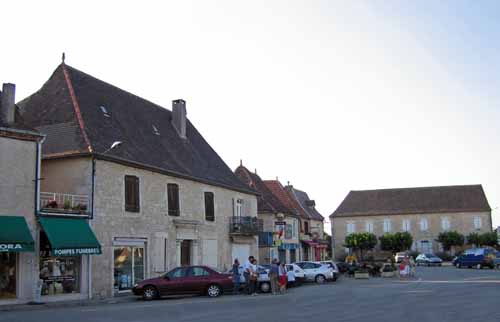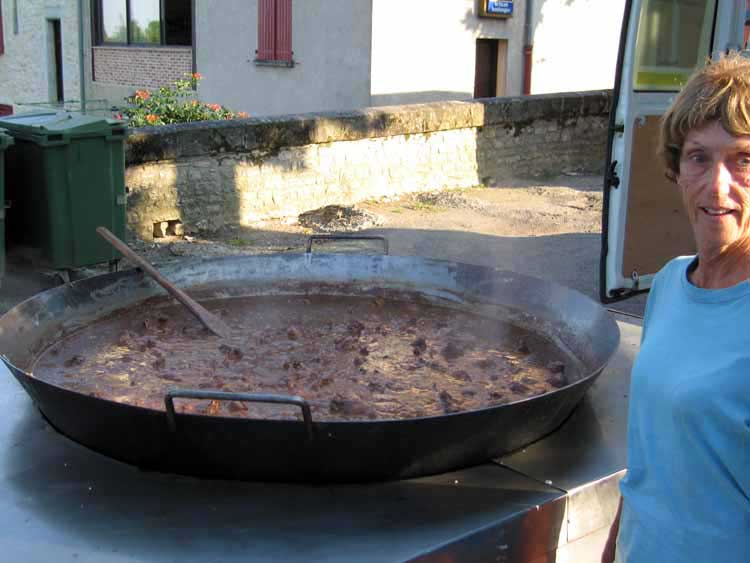Wednesday, 13 July 2005
Distance 27 km
Duration 5 hours 20 minutes
Ascent 691 m, descent 516 m
Map 48 of the TOP100 blue series (now superseded)
Map 57 of the TOP100 blue series (now superseded)

We started very early because of the weather forecast, and because we were not at all sure what lay ahead. Our aim was the cross the causse to the Lot river, stopping on the way at Labastide-Murat, a town that we knew nothing about except that it had a camping ground.
The citadel glowed like gold in the morning sun and the bells pealed for 7 o’clock as we went down through the Porte Sainte. In the single street of Rocamadour, hotel staff were busy but nothing was open so we had to do without a caffeine hit.

There were two GRs leaving from here, the GR6 to the west (which we had taken last time) and the GR46 to the south. At the second attempt we found the branching point and took the south track, over a stone bridge and up a steep and stony path, with a sheer drop on one side and a wall on the other, until we crossed the road coming from l’Hospitalet.
The GR was a veritable goat-track, remarkably rough considering that we were out of the river valley. There were ragged fields and patches of wood.
At Couzou we had hope of refreshment, as there was both a snack-bar and a restaurant, but both were closed. We sat on the vine-covered terrace of the restaurant and pretended that the cold water we were drinking was hot milky coffee in big, dark green cups.

After this we decided to stick to the road, thinking we would find a bar at Carlucet, which had twice the population of Couzou. The road was quiet and meandering, largely through forest.
Carlucet was a charming little street of cottages on a spine of land rising from the church to a war memorial.
Some workmen were renovating a house and two old ladies tottered down the road, but apart from that there was nobody in sight, and certainly no sign of a bar. It was dispiriting.

We carried on for a while in the baking heat and at 11 o’clock we stopped beside the road for a preliminary lunch. We had plenty of water because we had raided a tap in Carlucet and it was very reviving.
When we came near the feeder road for the autoroute, our little road became a stony track and threaded through a needle’s eye under it, then reverted to a normal bitumen road.
Soon we were joined by the errant GR and followed it for the last few kilometres into Labastide-Murat.

We passed a rest area for the autoroute, with a fine artificial lake, lawns and seats, very different from the causse around it, and started climbing towards the town.
It was on a moderate rise with views across the plateau in all directions. As we walked into the central square our hearts sank, as there was nothing to be seen but a few closed and shuttered shops. Another few steps brought us the longed-for sight of a large hotel, with doors flung open and a terrace full of cheerful umbrellas.
It was almost one o’clock when we sat down for our first coffee of the day, and the pleasure was all the more poignant for the delay. We also had the prospect of a good meal at the same establishment in the evening.

In the wide square in front of the hotel, preparations were under way for the Bastille Day celebrations tonight – a communal coq au vin with music, then a dance. We had seen posters for it along the road.

The main road, or what had been the main road before the autoroute was put in, went through the square, but there was still plenty of room for trestle tables and a stage.
We read the local paper with our coffee – the Depêche du Midi, a much better paper than the Sud-Ouest – and were informed that the heatwave was predicted to return on Friday. It seemed that the roasting heat we had just endured was a cool spell.
The municipal camping ground was a short walk away, at the other end of the town. It had shadier trees and softer grass than most commercial places and the cost was €4.94. Across the road was the swimming pool, from which came the joyful shrieks of a multitude of children.
The showers were hot and strong, but it was necessary to keep pressing the button, otherwise the flow would instantly stop. With some difficulty, we washed ourselves and all our clothes one-handed.
The great hero of the town is Joachim Murat, one of Napoleon’s commanders, who took the precaution of marrying Napoleon’s youngest sister and was thereafter loaded with honours. He even became king of Naples, but ended his days in front of a firing squad at the age of 48. The town was known as Labastide-Fortunière before the name was changed to honour their most illustrious son.
There was another small tent near ours, belonging to a pair of white-haired, weather-beaten Dutchmen who were cycling to Compostela. Their destination for tomorrow was Moissac, 100 km away, but breathtakingly far by our reckoning. Apart from that, all the campers had multi-room canvas mansions or self-contained vans.
In the slight coolness of evening we went back to the square where the great annual celebration of French republicanism was about to begin.
We admired the bath-sized vat of coq au vin bubbling amongst the tables, dark and velvety, crammed with the legs of every chicken for miles around, and perhaps a few monarchist legs for good measure. The first villagers were gathering in their summer best, clutching knives, forks and plates for the feast.

After a drink on the terrasse of the hotel, we were directed upstairs to another terrasse overlooking the side street and roofed with market umbrellas, where a crowd of diners was already hard at work.
Instead of having the full menu, we had the ‘saveur du jour’, which was a grilled steak with half a dozen different beautifully prepared vegetables around it. Preceded by a large salad and accompanied by bread and wine, it was a lovely meal.
The music floated up to us from the communal festivities and we heard it even from the camping ground later, as a pleasant lullaby.
Previous section: Souillac to Rocamadour